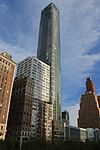Downtown Community House
The Downtown Community House at 105-107 Washington Street is a six-story, five-bay red brick building that is among the last vestiges of the Lower West Side of Manhattan's former life as an ethnic neighborhood known as “Little Syria.” From the time of its establishment, the Bowling Green Neighborhood Association, housed in the Downtown Community House beginning in 1926, was a pioneering organization that served the local immigrant population as a settlement house and continued to provide services for the area well after the community house became defunct. Built in 1925 with philanthropic funds from William H. Childs, the founder of the Bon Ami household cleaner company, the Downtown Community House was designed by John F. Jackson, architect of over 70 Y.M.C.A. buildings and community centers, and through its Colonial Revival style speaks to an underlying desire for the neighborhood's immigrant population to become Americanized and associate themselves with the country's foundations. In recent years, a collection of historic preservationists and Arab-American activists have lobbied the Landmarks Preservation Commission and its Chairman Robert Tierney to designate the building as a city landmark.
Excerpt from the Wikipedia article Downtown Community House (License: CC BY-SA 3.0, Authors).Downtown Community House
Washington Street, New York Manhattan
Geographical coordinates (GPS) Address Nearby Places Show on map
Geographical coordinates (GPS)
| Latitude | Longitude |
|---|---|
| N 40.7084 ° | E -74.0141 ° |
Address
Washington Street 103
10006 New York, Manhattan
New York, United States
Open on Google Maps









